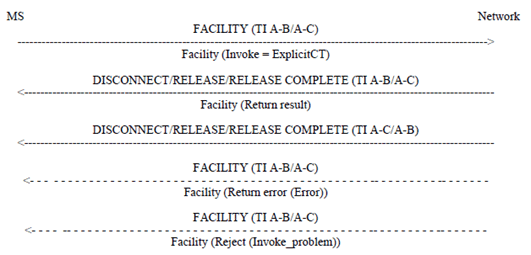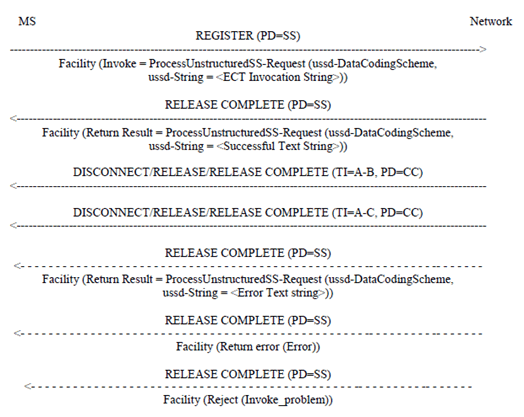TS 24.091
Explicit Call Transfer (ECT)
Supplementary Service
V18.0.0 (PDF)
2024/03 13 p.
V17.0.0
2022/03 13 p.
V16.0.0
2020/06 13 p.
V15.0.0
2018/06 13 p.
V14.0.0
2017/03 13 p.
V13.0.0
2015/12 13 p.
V12.0.0
2014/09 13 p.
V11.0.0
2012/09 13 p.
V10.0.0
2011/04 13 p.
V9.0.0
2009/12 13 p.
V8.0.0
2008/12 13 p.
V7.0.0
2007/07 13 p.
V6.0.0
2005/01 13 p.
V5.0.0
2002/06 13 p.
V4.0.1
2002/06 13 p.
V3.0.0
1999/04 13 p.
GSM Rel-98 v7.0.1
2000/01 12 p.
GSM Rel-97 v6.0.1
1998/11 12 p.
GSM Rel-96 v5.1.2
1996/03 14 p.
- Rapporteur:
- Mr. Wiehe, Ulrich
Nokia Solutions & Networks (S)
Content for TS 24.091 Word version: 18.0.0
1 Scope p. 5
The present document gives the stage 3 description of the call transfer supplementary services.
The present document specifies the procedures used at the radio interface (Reference point Um as defined in TS 24.002) for normal operation, registration, erasure, activation, deactivation, invocation and interrogation of call transfer supplementary services. Provision and withdrawal of supplementary services is an administrative matter between the mobile subscriber and the service provider and cause no signalling on the radio interface.
In TS 24.010 the general aspects of the specification of supplementary services at the layer 3 radio interface are given.
3GPP TS 24.080 specifies the formats and coding for the supplementary services.
Definitions and descriptions of supplementary services are given in TS 22.004, 3GPP TS 22.08x and 3GPP TS 22.09x-series. TS 22.091 is related specifically to call transfer supplementary services.
The technical realization of supplementary services is described in TS 23.011, 3GPP TS 23.08x and 3GPP TS 23.09x-series. TS 23.091 is related specifically to call transfer supplementary services.
The procedures for Call Control, Mobility Management and Radio Resource management at the layer 3 radio interface are defined in TS 24.007 and TS 24.008.
The following supplementary services belong to the call transfer supplementary services and are described in the present document:
- Explicit Call Transfer (ECT) (see clause 4).
2 References p. 5
The following documents contain provisions which, through reference in this text, constitute provisions of the present document.
- References are either specific (identified by date of publication, edition number, version number, etc.) or non-specific.
- For a specific reference, subsequent revisions do not apply.
- For a non-specific reference, the latest version applies. In the case of a reference to a 3GPP document (including a GSM document), a non-specific reference implicitly refers to the latest version of that document in the same Release as the present document.
[1]
TR 21.905: "Vocabulary for 3GPP Specifications".
[2]
TS 22.004: "General on supplementary services".
[3]
TS 22.030: "Man Machine Interface (MMI) of the Mobile Station (MS)".
[4]
TS 22.081: "Line identification supplementary services - Stage 1".
[5]
TS 22.082: "Call Forwarding (CF) supplementary services - Stage 1".
[6]
TS 22.083: "Call Waiting (CW) and Call Hold (HOLD) supplementary services - Stage 1".
[7]
TS 22.084: "MultiParty (MPTY) supplementary services - Stage 1".
[8]
TS 22.085: "Closed User Group (CUG) supplementary services - Stage 1".
[9]
TS 22.086: "Advice of Charge (AoC) Supplementary Services - Stage 1".
[10]
TS 22.088: "Call Barring (CB) supplementary services - Stage 1".
[11]
TS 22.090: "Unstructured Supplementary Service Data (USSD ) Stage 1".
[12]
TS 22.091: "Explicit Call Transfer (ECT)".
[13]
TS 23.011: "Technical realization of supplementary services".
[14]
TS 23.081: "Line identification supplementary services - Stage 2".
[15]
TS 23.082: "Call Forwarding (CF) supplementary services - Stage 2".
[16]
TS 23.083: "Call Waiting (CW) and Call Hold (HOLD) supplementary services - Stage 2".
[17]
TS 23.084: "MultiParty (MPTY) supplementary services - Stage 2".
[18]
TS 23.085: "Closed User Group (CUG) supplementary services - Stage 2".
[19]
TS 23.086: "Advice of Charge (AoC) supplementary services - Stage 2".
[20]
TS 23.088: "Call Barring (CB) supplementary services - Stage 2".
[21]
TS 23.090: "Unstructured supplementary services operation - Stage 2".
[22]
TS 23.091: "Explicit Call Transfer (ECT) supplementary service - Stage 2".
[23]
TS 24.002: "GSM-UMTS Public Land Mobile Network (PLMN) access reference configuration".
[24]
TS 24.007: "Mobile radio interface signalling layer 3; General aspects".
[25]
TS 24.008: "Mobile radio interface layer 3 specification".
[26]
TS 24.010: "Mobile radio interface layer 3; Supplementary services specification; General aspects".
[27]
TS 24.080: "Mobile radio interface layer 3 supplementary services specification; Formats and coding".
3 Abbreviations p. 6
The abbreviations used in the present document are listed in TR 21.905.
4 Explicit Call Transfer (ECT) p. 6
4.1 Normal operation p. 6
The Explicit Call Transfer (ECT) function should be invoked in association with two existing calls which one is answered and in the held state and the other is answered and active or alerting.
The Mobile Station (MS) invokes the service by sending a FACILITY message to the network containing the ECT request (ECT request). This ECT request indicates to the network that the mobile subscriber wishes the two calls to be connected together. The MS shall not change the basic call state or the auxiliary state of either call when sending ECT request.
The network will normally accept the ECT request and connect the two calls, indicates the success of the ECT request to the served subscriber and disconnect afterwards the served mobile subscriber from both calls (see Figure 1).
If the ECT request is not accepted, the network will indicate the error to the served subscriber (see Figure 1) and leaves the two calls to the condition it was in prior to the ECT request. The network confirms with the same transaction identifier. The detailed coding of the different error values are specified in TS 24.080. Which error value is used in which error case is described below.
During the ECT operation the MS shall run a timer TECT. This timer is started when the operation is sent, and stopped when a response is received from the network. If this timer expires the MS shall assume that the operation has failed, locally release the invokeID, and may re-attempt the operation or inform the user of the failure.
4.2 Explicit Call Transfer invocation p. 7

A-C/A-B indicates the TI of the other call.
In the following Table, the use of the different error values is described:
| Error | Error case |
|---|---|
| IllegalSS-Operation |
|
| SS-ErrorStatus | the served subscriber has not subscribed to ECT |
| SS-NotAvailable | SS is not available in current location area |
| SS-Incompatibility | SS Interaction violation |
| FacilityNotSupported | Facility not supported in VPLMN |
| SystemFailure | problems in an entity or network resources |
| ResourcesNotAvailable | problems to allocate resources |
| CallBarred | contravention with the active barring program |
4.3 Notification to the remote parties p. 7
If the network received a non-zero SS Screening indicator from the remote party's MS the network shall send a notification to the remote party indicating that the call has been transferred and towards the previously-held party to indicate that he is now retrieved.
If the network did not receive a non-zero SS Screening indicator from the remote party's MS it shall not send a notification.
The content of the Notification Indicator and the Redirection Number in detail is given in TS 23.091 and the coding in TS 24.080. For the following it is assumed that the Line Identities of the remote parties are available and allowed to be presented to the remote parties.
4.3.1 Notification to the held remote party p. 8
If ECT was invoked in the active state the previous-held remote party will be notified at the invocation of ECT (see Figure 2).

Figure 2: Notification of invocation (at active state) to held remote party
(⇒ copy of original 3GPP image)
(⇒ copy of original 3GPP image)
If ECT was invoked in the alerting state the previous-held remote party will be notified at the invocation of ECT (Figure 3) and again at the receipt of the ANSWER message from the previous-alerting remote party (Figure 4).

Figure 3: Notification of invocation (at alerting state) to held remote party
(⇒ copy of original 3GPP image)
(⇒ copy of original 3GPP image)

Figure 4: Notification to the previous-held remote party at receipt of the ANSWER message
(⇒ copy of original 3GPP image)
(⇒ copy of original 3GPP image)
by the previous-alerting remote party
4.3.2 Notification to the active or alerting remote party p. 8

Figure 5: Notification of invocation to previous-active or previous-alerting remote party
(⇒ copy of original 3GPP image)
(⇒ copy of original 3GPP image)
4.4 Activation and deactivation p. 8
Activation and deactivation of ECT cause no signalling on the radio path.
4.5 Registration, erasure and interrogation p. 9
Registration, erasure and interrogation of ECT are not applicable.
5 Support by "old" MSs p. 9
MSs which do not explicitly support ECT are not precluded from attempting to invoke ECT. It is however, an operator option to support the invocation of ECT by these mobile stations. Where operators support this option, the mechanism employed to offer the ECT service to these MSs shall be USSD. However, it should be noted that it may not be possible using this mechanism to offer the same degree of service to the served subscriber as described in clause 4.
5.1 Explicit Call Transfer invocation p. 9
MS A invokes the service by sending a REGISTER message to the network using a call independent supplementary service (SS) transaction, with the facility information element, indicating ProcessUnstructuredSS-Request (the MMI is specified in TS 22.030).
If the invocation of ECT is successful, then after the SS transaction has been cleared, the network shall release the CC transactions.
If the invocation of ECT is not successful, then the CC transactions shall not be released.

Figure 6: Invocation of Explicit Call Transfer for non supporting MSs
(⇒ copy of original 3GPP image)
(⇒ copy of original 3GPP image)
5.2 Notification to the remote parties p. 10
No alternative procedures are defined for sending notifications to remote parties indicating that the call has been transferred.